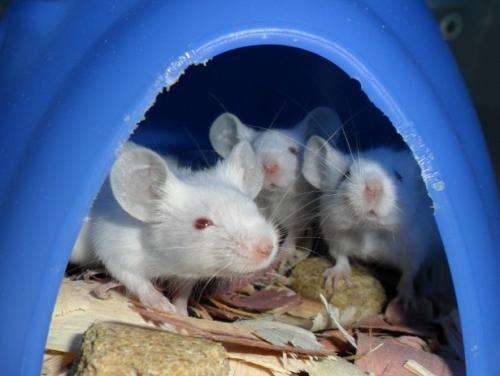November 19, 2014 report
Captive mice and native mice don't care to breed together, study finds

(Phys.org) —A combined team of researchers from the University of Melbourne and the organization Wildlife Conservation and Science has found that mice grown in captivity don't necessarily breed with mice living in their natural environment—a finding that could have an impact on programs designed to increase diversity in wild populations. In their paper published in Royal Society Biology Letters, the researchers describe their study and results and suggest that there could be broad implications regarding what they found.
For many years, wildlife experts have grown animals in captivity, bred them to increase their numbers, and then released some of the offspring into the wild. The aim has been to increase populations at risk by adding to their numbers and by increasing genetic diversity. But now, it appears, such programs may not be meeting with as much success as has been hoped because at least one species, common house mice, don't breed very freely between native mice and those raised in captivity.
The experimenters enlisted the assistance of 108 captive mice, which they note were heaver than their native cousins due to a family history of living in captivity—they'd been living that way for three generations. The captive mice were then placed in a semi-native environment with an equal number of mice that had been caught in the wild for use in the study. The mice were left to their own devices for twenty weeks, after which time, the researchers captured, counted and tested offspring that had been born during that time. They found that of the 189 that were produced, just 17 percent of the pups were the result of breeding between captive mice and those brought in from the wild.
The researchers can't say for certain why the two mice populations didn't breed as much together as had been expected but speculate that it might have been due to differences in phenotypes, smell or other physical factors, or because of differences in behavior. They plan to continue the study, watching more closely as the mice procreate to see if they can find the true reason. In the meantime, the findings by the team are likely to cause other such studies to be undertaken with other species to determine if releasing captive animals into the field is actually having the desired impacts.
More information: Assortative mating among animals of captive and wild origin following experimental conservation releases, Biology Letters, Published 19 November 2014. DOI: 10.1098/rsbl.2014.0656
ABSTRACT
Captive breeding is a high profile management tool used for conserving threatened species. However, the inevitable consequence of generations in captivity is broad scale and often-rapid phenotypic divergence between captive and wild individuals, through environmental differences and genetic processes. Although poorly understood, mate choice preference is one of the changes that may occur in captivity that could have important implications for the reintroduction success of captive-bred animals. We bred wild-caught house mice for three generations to examine mating patterns and reproductive outcomes when these animals were simultaneously released into multiple outdoor enclosures with wild conspecifics. At release, there were significant differences in phenotypic (e.g. body mass) and genetic measures (e.g. Gst and F) between captive-bred and wild adult mice. Furthermore, 83% of offspring produced post-release were of same source parentage, inferring pronounced assortative mating. Our findings suggest that captive breeding may affect mating preferences, with potentially adverse implications for the success of threatened species reintroduction programmes.
Journal information: Biology Letters
© 2014 Phys.org

















